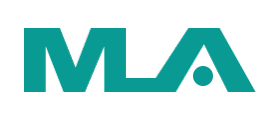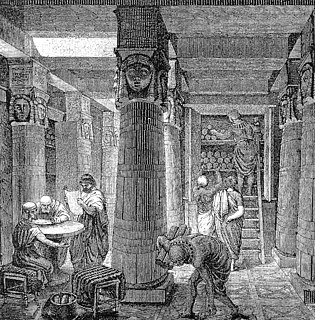Related Research Articles

A library is a collection of materials, books or media that are easily accessible for use and not just for display purposes. It is responsible for housing updated information in order to meet the user's needs on a daily basis. A library provides physical or digital access materials, and may be a physical location or a virtual space, or both. A library's collection can include printed materials and other physical resources in many formats such as DVD, CD and Cassette as well as access to information, music or other content held on bibliographic databases.

A librarian is a person who works professionally in a library, providing access to information, and sometimes social or technical programming, or instruction on information literacy to users.
The American Library Association (ALA) is a nonprofit organization based in the United States that promotes libraries and library education internationally. It is the oldest and largest library association in the world, with more than 57,000 members.
The Chartered Institute of Library and Information Professionals, since 2017 branded CILIP: The library and information association, is a professional body for librarians, information specialists and knowledge managers in the United Kingdom. It was established in 2002 as a merger of the Library Association and the Institute of Information Scientists (IIS).
A book discussion club is a group of people who meet to discuss a book or books that they have read and express their opinions, likes, dislikes, etc. It is more often called simply a book club, a term that is also used to describe a book sales club, which can cause confusion. Other frequently used terms to describe a book discussion club include reading group, book group, and book discussion group. Book discussion clubs may meet in private homes, libraries, bookstores, online forums, pubs, and in cafés or restaurants over meals or drinks.

The Medical Library Association (MLA) is a nonprofit, educational organization with more than 3,400 health sciences information professional members and partners worldwide.

A law library is a special library used by law students, lawyers, judges and their law clerks, historians and other scholars of legal history in order to research the law. Law libraries are also used by people who draft or advocate for new laws, e.g. legislators and others who work in state government, local government, and legislative counsel offices or the U.S. Office of Law Revision Counsel and lobbying professionals. Self-represented, or pro se, litigants also use law libraries.
A health or medical library is designed to assist physicians, health professionals, students, patients, consumers, medical researchers, and information specialists in finding health and scientific information to improve, update, assess, or evaluate health care. Medical libraries are typically found in hospitals, medical schools, private industry, and in medical or health associations. A typical health or medical library has access to MEDLINE, a range of electronic resources, print and digital journal collections, and print reference books. The influence of open access (OA) and free searching via Google and PubMed has a major impact on the way medical libraries operate.
The Canadian Health Libraries Association or Association des bibliothèques de la santé du Canada was founded in 1976. It represents the views of Canadian Health sciences librarians to governments, the health community and fellow librarians.

A school library is a library within a school where students, staff, and often, parents of a public or private school have access to a variety of resources. The goal of the school library media center is to ensure that all members of the school community have equitable access "to books and reading, to information, and to information technology." A school library media center "uses all types of media... is automated, and utilizes the Internet [as well as books] for information gathering." School libraries are distinct from public libraries because they serve as "learner-oriented laboratories which support, extend, and individualize the school's curriculum... A school library serves as the center and coordinating agency for all material used in the school."
The Art Libraries Society of North America was founded in 1972. It is an organization made up of approximately 1,000 art librarians, library students and visual resource professionals.
A one-person library (OPL) is a library led by a single person or a single professional librarian without any professional library peers. These libraries represent the vast majorities of libraries in the world. They may be found in public and governmental settings, in companies and any organisations, in academic and research and as private initiatives for many subjects. Very often they are specialized towards a specific subject of collection and thus part of the special libraries scene. In 1972 the U.S. Special Libraries Association (SLA) invited at their annual conference to a discussion on the issue of such a library type under the heading "The One Man Library" led by Guy St. Clair by then librarian at the University Club of New York of New York City. Thanks to the long time engagement and dedication of Guy St. Clair after the initial meeting the One Person Library became a global movement proliferating to other countries throughout the world.
The Council of Australian University Librarians (CAUL) is a representative leadership body for university libraries in Australia. The CAUL members represent 39 Australian University Institutions and 8 New Zealand University Institutions. Membership is restricted to library directors whose parent institutions are full members of Universities Australia.

The Scholarly Publishing and Academic Resources Coalition (SPARC) is an international alliance of academic and research libraries developed by the Association of Research Libraries in 1998 which promotes open access to scholarship. The coalition currently includes some 800 institutions in North America, Europe, Japan, China and Australia.
The British and Irish Association of Law Librarians is a professional body which represents information professionals working with legal information. BIALL is a self-supporting association which draws its income primarily from membership subscriptions.

Library science is an interdisciplinary or multidisciplinary field that applies the practices, perspectives, and tools of management, information technology, education, and other areas to libraries; the collection, organization, preservation, and dissemination of information resources; and the political economy of information. Martin Schrettinger, a Bavarian librarian, coined the discipline within his work (1808–1828) Versuch eines vollständigen Lehrbuchs der Bibliothek-Wissenschaft oder Anleitung zur vollkommenen Geschäftsführung eines Bibliothekars. Rather than classifying information based on nature-oriented elements, as was previously done in his Bavarian library, Schrettinger organized books in alphabetical order. The first American school for library science was founded by Melvil Dewey at Columbia University in 1887.

The Mountain Plains Library Association (MPLA) is a non-profit organization based in the western United States that promotes the development of librarians and libraries by providing educational and networking opportunities to members.
The Southeastern Library Association (SELA) is an organization that collaborates with different library associations within the Southeastern United States, including Alabama, Arkansas, Florida, Georgia, Kentucky, Louisiana, Mississippi, North Carolina, South Carolina, Tennessee, Virginia, and West Virginia.
The Western Association of Map Libraries (WAML) is a not-for-profit organization dedicated to the promotion, preservation, and use of maps and geospatial information. Its purpose as stated in its by-laws is:
NASIG is an independent professional association of librarians and academic publishing professionals, working to advance and transform the management of information resources in all formats and business models, with an emphasis on scholarly communications, serials and electronic resources. Founded in 1985, NASIG is registered in the state of New York as a 501(c)(3) non-profit organization.
References
- ↑ Schopflin and Nelsson (2007) "Media libraries, IN British Librarianship and Information Work 2001–2005 Archived 2014-04-19 at the Wayback Machine "